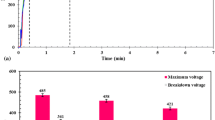Abstract
TiO2-SiO2 composite films were produced on commercially pure titanium (CP-Ti) substrate by a sol–gel method to investigate the behavior of sol aging time and its potential effects on the structural and electrochemical properties of composite coatings. Anatase-TiO2 and quartz-SiO2 peaks were observed on all composite coated samples according to XRD results. It was observed that the average grain size increased with sol aging time. Also, the average smallest grain size was seen at composite coatings prepared from unaged sol according to the width of the peaks. Electrochemical behavior of coated samples was mainly investigated by potentiodynamic polarization and Electrochemical Impedance Spectroscopy (EIS) in Simulated Body Fluid (SBF) solution. In corrosion tests, the composite coatings showed better anti-corrosion behavior than that of uncoated samples. In addition, the corrosion properties of the composite films were considerably affected by sol aging time. Corrosion resistance of coatings decreased with increasing aging time and the best result was obtained from composite coatings prepared from unaged sol.
Similar content being viewed by others
References
Ahn Y K, Kim H G, Park H K, Kim G H, Jung K H, Lee C W, Kim W Y, Lim S H, Lee B S. Mechanical and microstructural characteristics of commercial purity titanium implants fabricated by electron-beam additive manufacturing. Materials Letters, 2017, 187, 64–67.
Rautray T R, Narayanan R, Kim K H. Ion implantation of titanium based biomaterials. Progress in Materials Science, 2011, 56, 1137–1177.
Shukla A, Balasubramaniam R. Effect of surface treatment on electrochemical behavior of CP Ti, Ti–6Al–4V and Ti–13Nb–13Zr alloys in simulated human body fluid. Corrosion Science, 2006, 48, 1696–1720.
Kim H, Kim W. Annealing effects on the corrosion resistance of ultrafine-grained pure titanium. Corrosion Science, 2014, 89, 331–337.
Albayrak C, Alsaran A. Corrosion behaviour after anodising of pre-nitrided CP-Ti. Corrosion Engineering, Science and Technology, 2011, 46, 807–811.
Bessho K, Fujimura K, Iizuka T. Experimental long-term study of titanium ions eluted from pure titanium miniplates. Journal of Biomedical Materials Research Part A, 1995, 29, 901–904.
Catauro M, Bollino F, Papale F, Giovanardi R, Veronesi P. Corrosion behavior and mechanical properties of bioactive sol-gel coatings on titanium implants. Materials Science and Engineering: C, 2014, 43, 375–382.
Çomakli O, Yetim T, Çelik A. The effect of calcination temperatures on wear properties of TiO2 coated CP-Ti. Surface and Coatings Technology, 2014, 246, 34–39.
Banerjee D A, Kessman A J, Cairns D R, Sierros K A. Tribology of silica nanoparticle-reinforced, hydrophobic sol–gel composite coatings. Surface and Coatings Technology, 2014, 260, 214–219.
Wang H, Akid R, Gobara M. Scratch-resistant anticorrosion sol–gel coating for the protection of AZ3magnesium alloy via a low temperature sol–gel route. Corrosion Science, 2010, 52, 2565–2570.
Guglielmi M. Sol–gel coatings on metals. Journal of Sol–Gel Science and Technology, 1997, 8, 443–449.
Catauro M, Bollino F, Giovanardi R, Veronesi P. Modification of Ti6Al4V implant surfaces by biocompatible TiO2/PCL hybrid layers prepared via sol-gel dip coating: Structural characterization, mechanical and corrosion behavior. Materials Science and Engineering: C, 2017, 74, 501–507.
Yusoff M M F, Kadir M R A, Iqbal N, Hassan M A, Hussain R. Dipcoating of poly (e-caprolactone)/hydroxyapatite composite coating on Ti6Al4V for enhanced corrosion protection. Surface and Coatings Technology, 2014, 245, 102–107.
Vaghari H, Sadeghian Z, Shahmiri M. Investigation on synthesis, characterisation and electrochemical properties of TiO2–Al2O3 nanocomposite thin film coated on 31L stainless steel. Surface and Coatings Technology, 2011, 205, 5414–5421.
Gu G, Zhang Z, Dang H. Preparation and characterization of hydrophobic organic–inorganic composite thin films of PMMA/SiO2/TiO2 with low friction coefficient. Applied Surface Science, 2004, 221, 129–135.
Masanta M, Ganesh P, Kaul R, Choudhury A R. Microstructure and mechanical properties of TiB2–TiC–Al2O3–SiC composite coatings developed by combined SHS, sol–gel and laser technology. Surface and Coatings Technology, 2010, 204, 3471–3480.
Tsai R Y, Ho F C. Liquid Crystal Display Devices Having Undercoat and Overcoat Made of TiO2–SiO2Composite Material, Patent US5808715, USA, 1998.
Surowska B, Bienias J. Composite layers on titanium and Ti6Al4V alloy for medical applications. Journal of Achievements in Materials and Manufacturing, 2010, 43, 162–169.
Neto P L, Atik M, Avaca L A, Aegerter M A. Sol-gel coatings for chemical protection of stainless steel. Journal of Sol-Gel Science and Technology, 1994, 2, 529–534.
Boroujeny B. Design and investigation of TiO2–SiO2 thin films on AISI 316L stainless steel for tribological properties and corrosion protection. Journal of Advanced Materials and Processing, 2015, 3, 13–24.
Kokubo T, Takadama H. How useful is SBF in predicting in vivo bone bioactivity? Biomaterials, 2006, 27, 2907–2915.
Li S, Fu J. Improvement in corrosion protection properties of TiO2 coatings by chromium doping. Corrosion Science, 2013, 68, 101–110.
Curkovic L, Curkovic H O, Salopek S, Renjo M M, Šegota S. Enhancement of corrosion protection of AISI 30stainless steel by nanostructured sol–gel TiO2 films. Corrosion science, 2013, 77, 176–184.
Afshari V, Dehghanian C. Effects of grain size on the electrochemical corrosion behaviour of electrodeposited nanocrystalline Fe coatings in alkaline solution. Corrosion Science, 2009, 51, 1844–1849.
Yazici M, Çomakli O, Yetim T, Yetim A F, Çelik A. The effect of plasma nitriding temperature on the electrochemical and semiconducting properties of thin passive films formed on 31L stainless steel implant material in SBF solution. Surface and Coatings Technology, 2015, 261, 181–188.
Çomakli O, Yazici M, Yetim T, Yetim A F, Celik A. The effect of calcination temperatures on structural and electrochemical properties of TiO2 film deposited on commercial pure titanium. Surface and Coatings Technology, 2016, 285, 298–303.
Author information
Authors and Affiliations
Corresponding author
Rights and permissions
About this article
Cite this article
Çomakli, O., Yazici, M., Yetim, T. et al. The Effects of aging time on the structural and electrochemical properties of composite coatings on Cp-Ti substrate. J Bionic Eng 14, 532–539 (2017). https://doi.org/10.1016/S1672-6529(16)60419-5
Published:
Issue Date:
DOI: https://doi.org/10.1016/S1672-6529(16)60419-5




